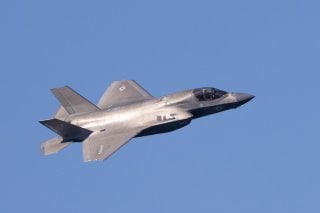The F-35 Fighter Can’t Fly Very Far For All That Cash
The latest stateside kvetch about the F-35 is the relative lack of proverbial “bang for the buck” relative to its exorbitant cost, or more literally, the mileage that this controversial warbird generates relative to the U.S. taxpayer dollars spent on it.
Pity the poor Lockheed Martin F-35 Lightning II fifth-generation stealth fighter. This latest & greatest brainchild of Lockheed Martin’s legendary “Skunk Works” division just can’t seem to escape controversy, in terms of reliability issues and seemingly never-ending cost overruns. At least the ones owned by the U.S. Air Force, Navy, and Marine Corps. By contrast, the Israeli Air Force (Zroa HaAvir VeHahalal) pilots have used their F-35I Adir (“Mighty One”) in combat multiple times quite successfully, and multiple Royal Australian Air Force (RAAF) officers whom I’ve interviewed on the subject (including Air Commodore Angus Porter, the air attache for the Australian Embassy in the United States) have told me straight up, “We love them!”
That said, the latest stateside kvetch about the F-35 is the relative lack of proverbial “bang for the buck” relative to its exorbitant cost, or more literally, the mileage that this controversial warbird generates relative to the U.S. taxpayer dollars spent on it. Let us explore this further, shall we?
The Latest Growing Pains
The crux of the story comes courtesy of my colleague Maya Carlin, in an October 20, 2024 article for The National Interest titled “The Navy’s F-35 Has an Embarrassing Flaw It Would Rather Not Admit”:
“The F-35C variant offers a combat radius of 600 nautical miles [690 mi; 1,111 km], slightly surpassing the F/A-18 Super Hornet’s 570 nautical miles for air-to-air missions. However, its reduced payload and reliance on carriers for refueling require carriers to operate closer to adversaries, exposing them to advanced Chinese A2/AD [Anti-Access/Area Denial] systems with missiles reaching 2,200 nautical miles [2,531 mi; 4.074 km].”
To put that fuel inefficiency in a dollars & sense perspective, the approximate unit cost of an F-35 is $109 million; which equates to $181,666,666 per nautical mile. (Boy, and you thought gas prices for automobiles were bad enough!)
Head-to-Head with Other Stealth Fighters
To put the Lightning II’s range shortcomings in numerical perspective, let’s see how it compares with the ranges of other fifth-generation fighters, both foreign and domestic:
- Lockheed Martin (Skunk Works again) F-22 Raptor (USA): Ferry range of 1,600 nmi (1,800 mi, 3,000 km) or more with 2 external fuel tanks; a combat range of 460 nmi (530 mi, 850 km) clean with 100 nmi (115 mi; 185 km) in supercruise, 595 nmi (685 mi; 1,102 km) in so-called “clean subsonic” mode
- Chengdu J-20 Weilong (“Mighty Dragon”; NATO reporting name “Fagin”; China): Ferry range of 5,500 km (3,400 mi; 3,000 nmi) with 2 external fuel tanks; a combat range of 2,000 km (1,200 mi, 1,100 nmi)
- Sukhoi Su-57 (NATO reporting name “Felon”; Russia): 3,500 km (2,200 mi, 1,900 nmi) subsonic, 4,500 km (2,796 mi; 2,429 nmi) from 2 outboard fuel tanks; 1,500 km (930 mi; 810 nmi) at supersonic speed
The Way Forward?
In spite of all of these controversies, the F-35 continues to attract foreign military sales (FMS) customers who continue to line up in droves to buy the fighter. Besides the aforementioned RAAF and Israeli Air Force, the following foreign entities have enthusiastically purchased the fighter:
-Japan Air Self-Defense Force (JASDF); twelve F-35As delivered, according to the World Directory of Modern Military Aircraft (WDMMA; using 2021 figures), with an additional 134 airframes on order
-Belgian Air Component (Luchtcomponent); one F-35A delivered out of thirty-four ordered
-Royal Canadian Air Force (RCAF); eighty-eight F-35As, with deliveries taking place from
-Royal Danish Air Force (Flyvevåbnet); ten F-35As delivered out of twenty-seven ordered
-Finnish Air Force (Ilmavoimat); sixty-four F-35As ordered as of 2022
-German Air Force (Luftwaffe); thirty-five F-35A ordered as of 2023
-Hellenic (Greek) Air Force (Polemikí Aeroporía); twenty F-35As on order, with delivery expected between late 2027 to early 2028 from 2026 to 2032
-Italian Air Force (Aeronautica Militare) and Navy (Marina Militare); ninety F-35As and F-35Bs delivered, with an additional twenty-five on the way
-Royal Netherlands Air Force (RNoAF; Luftforsvaret); forty F-35As delivered
-Polish Air Force (Siły Powietrzne); thirty-two F-35A “Husarz” ordered, with deliveries starting sometime this year and concluding in 2030
-Republic of Korea Air Force (ROKAF; Daehanminguk Gong-gun) and Navy (ROKN; Daehan-minguk Haegun); twenty F-35Bs planned
-Republic of Singapore Air Force; twelve F-35Bs on order as of February 2024 with first four specimens to be delivered in 2026
-Swiss Air Force (Forces aeriennes suisses); thirty-six F-35As ordered, with deliveries commencing in 2027 and culminating in 2030
-United Kingdom Royal Air Force (RAF) and Royal Navy Fleet Air Arm; thirty-four F-35Bs delivered, 138 more on order
Meanwhile, the Czech Air Force, Romanian Air Force (RoAF; Forțele Aeriene Romane), and Portuguese Air Force are all in the process of finalizing F-35 purchase deals.
All in all, not too shabby for such a seemingly overpriced and fuel-inefficient, short-range warbird, eh?
About the Author:
Christian D. Orr is a Senior Defense Editor for National Security Journal (NSJ). He is a former Air Force Security Forces officer, Federal law enforcement officer, and private military contractor (with assignments worked in Iraq, the United Arab Emirates, Kosovo, Japan, Germany, and the Pentagon). Chris holds a B.A. in International Relations from the University of Southern California (USC) and an M.A. in Intelligence Studies (concentration in Terrorism Studies) from American Military University (AMU). He has also been published in The Daily Torch , The Journal of Intelligence and Cyber Security, and Simple Flying. Last but not least, he is a Companion of the Order of the Naval Order of the United States (NOUS).
Image: Shutterstock.

